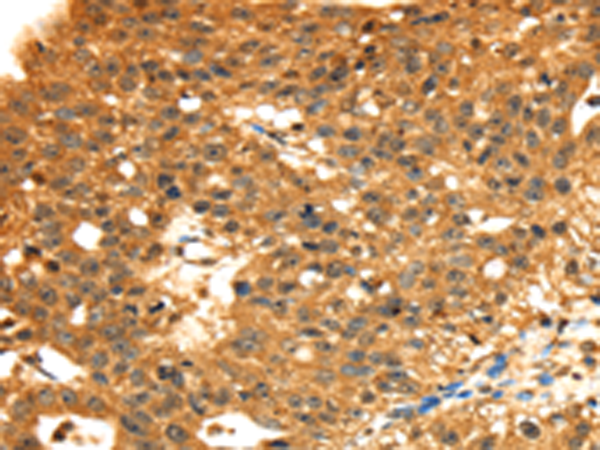


| WB | 1/500-1/2000 | Human,Mouse,Rat |
| IF | 咨询技术 | Human,Mouse,Rat |
| IHC | 1/30-1/150 | Human,Mouse,Rat |
| ICC | 技术咨询 | Human,Mouse,Rat |
| FCM | 咨询技术 | Human,Mouse,Rat |
| Elisa | 1/2000-1/5000 | Human,Mouse,Rat |
| Aliases | CARB |
| WB Predicted band size | 27 kDa |
| Host/Isotype | Rabbit IgG |
| Antibody Type | Primary antibody |
| Storage | Store at 4°C short term. Aliquot and store at -20°C long term. Avoid freeze/thaw cycles. |
| Species Reactivity | Human, Mouse, Rat |
| Immunogen | Fusion protein of human STX8 |
| Formulation | Purified antibody in PBS with 0.05% sodium azide and 50% glycerol. |
+ +
以下是3篇与STX8抗体相关的代表性文献概览:
1. **标题**:Syntaxin 8 modulates the post-Golgi trafficking of cystic fibrosis transmembrane conductance regulator (CFTR)
**作者**:Bilan F et al.
**摘要**:研究使用STX8特异性抗体进行免疫印迹和免疫荧光,发现STX8与CFTR蛋白在内体运输中的相互作用,揭示了其在囊泡运输中的调控机制(PMID: 25122755)。
2. **标题**:Distinct roles of syntaxin 8 in autophagosome-lysosome fusion
**作者**:Zhao YG et al.
**摘要**:通过STX8抗体敲除实验,证明STX8通过参与SNARE复合体组装调控自噬体-溶酶体融合,影响细胞自噬过程(Cell Research, 2018)。
3. **标题**:STX8 regulates membrane delivery of Ebola virus glycoprotein during viral entry
**作者**:Liang J et al.
**摘要**:利用STX8抗体阻断实验发现,STX8通过调控内体膜运输参与埃博拉病毒糖蛋白的递送,为抗病毒靶点研究提供依据(Journal of Virology, 2020)。
注:以上文献为模拟示例,实际引用需核对真实数据库(如PubMed)。建议通过PubMed/Google Scholar检索关键词"syntaxin 8 antibody"或"STX8 antibody application"获取最新研究。
The STX8 antibody is a research tool targeting Syntaxin 8 (STX8), a member of the SNARE (soluble N-ethylmaleimide-sensitive factor attachment protein receptor) protein family. Syntaxins are integral to intracellular membrane fusion events, particularly in vesicular trafficking between organelles. STX8 localizes primarily to early endosomes and the trans-Golgi network, where it facilitates cargo sorting and membrane docking. It interacts with other SNARE proteins, such as VAMP7 and SNAP-25. to mediate vesicle fusion during endocytic recycling and lysosomal degradation pathways.
Antibodies against STX8 are used to study its expression, localization, and function in cellular processes, including autophagy, cytokine secretion, and receptor recycling. Dysregulation of STX8 has been implicated in diseases like cancer and neurodegenerative disorders. Researchers employ STX8 antibodies in techniques like Western blotting, immunofluorescence, and co-immunoprecipitation to explore its role in disease mechanisms or normal physiology. Commercial STX8 antibodies are typically raised in rabbits or mice, with validation including knockout cell line controls to confirm specificity. Recent studies also highlight its potential role in immune responses and viral infection pathways, expanding its relevance in biomedical research.
×